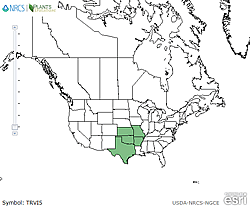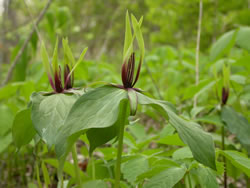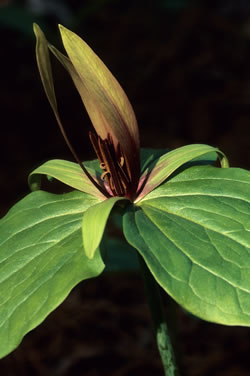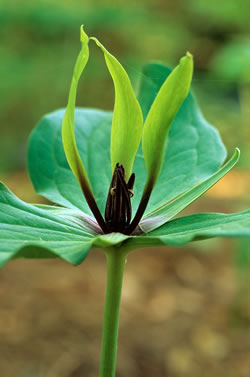Plant of the Week
 Trillium viridescens range map. USDA PLANTS Database.
Trillium viridescens range map. USDA PLANTS Database.
 Trillium viridescens. Magazine Mountains, Arkansas.
Trillium viridescens. Magazine Mountains, Arkansas.
Ozark Green Trillium (Trillium viridescens)
By Larry Stritch
All trillium species belong to the Liliaceae (lily) family and are rhizomatous herbs with unbranched stems. Trillium plants produce no true leaves or stems above ground. The “stem” is actually just an extension of the horizontal rhizome and produces tiny, scalelike leaves (cataphylls). The aboveground plant is technically a flowering scape, and the leaf-like structures are actually bracts subtending the flower. Despite their morphological origins, the bracts have external and internal structure similar to that of a leaf, function in photosynthesis, and most authors refer to them as leaves.
Trilliums are divided into two major groups, the pedicellate and sessile trilliums. In the pedicillate trilliums, either the flower sits upon a pedicel that extends from the whorl of bracts, “erect” above the bracts, or “nodding” recurved under the bracts. In the sessile trilliums, there is no pedicel and the flower appear to arise directly from the bracts.
Ozark green trillium belongs to the sessile trilliums. Ozark green trillium is a perennial herb that blooms from early April in the southern part of its range to mid-May in the northern part of its range. The flower is quite showy sitting atop its mottled bracts.
This plant is typically found on very mesic soils to the drier soils deciduous forests. It grows in rich, mesic soils on rocky hillsides with an occasional limestone outcrop and humusy soil over stiff clay.
Ozark green trillium occurs in large numbers in heavy alkaline and heavy riverine soils in the Ozark and Ouachita mountain regions in Arkansas Kansas, Missouri, Oklahoma, and Texas. They grow in rich mesic deciduous forests on sloping banks above floodplains, talus slopes, floodplain alluvium (growing there with cane, Arundinaria sp.).
For More Information
- PLANTS Profile - Trillium viridescens, Ozark Green Trillium
- Flora of North America: Trillium viridescens
- Case, F.W., R.B. Case. 1997. Trilliums. Timber Press, Portland, OR.
- Jacobs, D. L. and Jacobs R. L. 1997. Trilliums in Woodland and Garden: American Treasures. 152 pp. Eco-Gardens. Decatur, Georgia.



